Energy Demand Modeling Methodology of Key State Transitions of Turning Processes
Abstract
:1. Introduction
2. State Transition Classification Based on Energy Demand
3. Methodology
3.1. Energy Demand Model of Spindle Rotation (Ls→Hs)
3.2. Energy Demand Model of Positioning (Ls→Hs)
3.3. Energy Demand Model of Cooling (off→on)
3.4. Energy Demand Model of Tool Changing (off→on)
4. Case Study
4.1. Description of State Transition Cases
4.2. Discussion
5. Conclusions
Acknowledgments
Author Contributions
Conflicts of Interest
Nomenclature
| acceleration in feed table (mm/s2) | |
| depth of cut (mm) | |
| deceleration of feed table (mm/s2) | |
| energy demand of cooling (off→on) (J) | |
| energy demand of cooling device during cooling (off→on) (J) | |
| energy demand of supporting therblig during(off→on) (J) | |
| energy demand of positioning (Ls→Hs) (J) | |
| energy demand of feeding system during positioning (Ls→Hs) (J) | |
| energy demand of supporting therblig during positioning (Ls→Hs) (J) | |
| energy demand of spindle rotation (Ls→Hs) (J) | |
| energy demand of spindle system from spindle rotation start to peak power (J) | |
| energy demand of spindle system from peak power to stable power (J) | |
| energy demand of supporting therbligs during spindle rotation (Ls→Hs) (J) | |
| energy demand of tool changing (off→on) (J) | |
| energy demand of power peak caused by sub-action k when the rotating position number of the turret is (J) | |
| IEA | International Energy Agency |
| number of power peak when the rotating position number of the turret is | |
| feeding distance (mm) | |
| critical feeding distance (mm) | |
| LCA | Life Cycle Analysis |
| spindle speed (r/min) | |
| initial spindle speed (r/min) | |
| target spindle speed (r/min) | |
| power vector of forward-operating state | |
| state vector of forward-operating state | |
| power of therblig-chip conveying (W) | |
| power of therblig-cutting flood spraying (W) | |
| power function of feeding system during positioning (Ls→Hs) | |
| power of therblig- lighting (W) | |
| power of therblig- material cutting (W) | |
| power of therblig-standby operating (W) | |
| spindle power (W) | |
| power of spindle system from spindle rotation start to peak power (W) | |
| power peak of spindle speedup (W) | |
| power of therblig-tool changing (W) | |
| power of therblig-tool selecting (W) | |
| power of therblig-X-axis feeding (W) | |
| power of therblig-Y-axis feeding (W) | |
| power of therblig-Z-axis feeding (W) | |
| logical representations for ith type of therbligs | |
| transfer time of cooling (off→on) process (s) | |
| transfer time of positioning (Ls→Hs) (s) | |
| duration from spindle rotation start to peak power (s) | |
| duration from peak power to stable power (s) | |
| duration of spindle rotation (Ls→Hs) (s) | |
| total posts of the turret | |
| initial position of the turret | |
| target position of the turret | |
| equivalent acceleration torque of spindle (N·m) | |
| initial feed speed (mm/min) | |
| maximum feed rate (mm/min) | |
| maximum feeding speed of feed table (mm/min) | |
| angular acceleration of spindle (rad/s2) | |
| angular velocity of spindle rotation (rad/s) | |
| rotating position number of the turret |
References
- International Energy Agency. Energy Technology Perspectives 2010: Scenarios and Strategies to 2050; International Energy Agency: Paris, France, 2010. [Google Scholar]
- Wei, W.; Liang, Y.; Liu, F.; Mei, S.; Tian, F. Taxing strategies for carbon emissions: A bilevel optimization approach. Energies 2014, 7, 2228–2245. [Google Scholar] [CrossRef]
- Thollander, P.; Palm, J. Industrial energy management decision making for improved energy efficiency—Strategic system perspectives and situated action in combination. Energies 2015, 8, 5694–7703. [Google Scholar] [CrossRef]
- Anderberg, S.E.; Kara, S.; Beno, T. Impact of energy efficiency on computer numerically controlled machining. Proc. Inst. Mech. Eng. B J. Eng. 2010, 224, 531–541. [Google Scholar] [CrossRef]
- Brown, N.; Greenough, R.; Vikhorev, K.; Khattack, S. Precursor to using energy data as a manufacturing process variable. In Proceedings of the 6th IEEE International Conference on Digital Ecosystems Technologies (DEST), Campione d’Italia, Italy, 18–20 June 2012. [Google Scholar]
- Shao, G.; Kibira, D.; Lyons, K. A virtual machining model for sustainability analysis. In Proceedings of the ASME 2010 International Design Engineering Technical Conferences & Computers and Information in Engineering Conference, Montreal, QC, Canada, 15–18 August 2010. [Google Scholar]
- Zulaika, J.J.; Dietmair, A.; Campa, F.J.; López de Lacalle, L.N.; Verbeeten, W. Eco-efficient and Highly Productive Production Machines by Means of a Holistic Eco-Design Approach. In Proceedings of the 3rd Conference on Eco-Efficiency, Egmond an Zee, The Netherlands, 9–11 June 2010. [Google Scholar]
- Salonitis, K. Energy efficiency assessment of grinding strategy. Int. J. Energy Sect. Manag. 2015, 9, 20–37. [Google Scholar] [CrossRef]
- Salonitis, K.; Vidon, B.; Chen, D. A decision support tool for the energy efficient selection of process plans. Int. J. Mech. Manuf. Syst. 2015, 8, 63–83. [Google Scholar] [CrossRef]
- Gutowski, T. Energy and Environmental Issues for Manufacturing Processes. Available online: http://web.mit.edu/2.810/www/lecture2011/Environment.pdf (accessed on 27 August 2011).
- Gutowski, T.; Dahmus, J.; Thiriez, A. Electrical energy requirements for manufacturing processes. In Proceedings of the 13th CIRP International Conference on Life Cycle Engineering, Leuven, Belgium, 31 May–2 June 2006. [Google Scholar]
- Jia, S.; Tang, R.Z.; Lv, J.X. Therblig-based energy demand modeling methodology of machining process to support intelligent manufacturing. J. Intell. Manuf. 2014, 25, 913–931. [Google Scholar] [CrossRef]
- Lv, J.X.; Tang, R.Z.; Jia, S. Therblig-based energy supply modeling of CNC machine tools. J. Clean. Prod. 2014, 65, 168–177. [Google Scholar] [CrossRef]
- Li, W.; Kara, S. An empirical model for predicting energy consumption of manufacturing processes: A case of turning process. Proc. Inst. Mech. Eng. B J. Eng. 2011, 225, 1636–1646. [Google Scholar] [CrossRef]
- Balogun, V.A.; Mativenga, P.T. Modeling of direct energy requirements in mechanical machining processes. J. Clean. Prod. 2013, 41, 179–186. [Google Scholar] [CrossRef]
- Jia, S.; Tang, R.Z.; Lv, J.X.; Zhang, Z.W.; Yuan, Q.H. Energy modeling for variable material removal rate machining process: An end face turning case. Int. J. Adv. Manuf. Technol. 2016, 85, 2805–2818. [Google Scholar] [CrossRef]
- Zobel, T.; Malmgren, C. Evaluating the management system approach for industrial energy efficiency improvements. Energies 2016, 9, 774. [Google Scholar] [CrossRef]
- Tan, X.C.; Wang, Y.Y.; Gu, B.H.; Mu, Z.K.; Yang, C. Improved methods for production manufacturing processes in environmentally benign Manufacturing. Energies 2011, 4, 1391–1409. [Google Scholar] [CrossRef]
- Chiu, T.-Y.; Lo, S.-L.; Tsai, Y.-Y. Establishing an integration-energy-practice model for improving energy performance Indicators in ISO 50001 energy management systems. Energies 2012, 5, 5324–5339. [Google Scholar] [CrossRef]
- Peng, T.; Xu, X. Energy-efficient machining systems: A critical review. Int. J. Adv. Manuf. Technol. 2014, 72, 1389–1406. [Google Scholar] [CrossRef]
- Salonitis, K.; Ball, P. Energy efficient manufacturing from machine tools to manufacturing systems. Procedia CIRP 2013, 7, 634–639. [Google Scholar] [CrossRef]
- Salonitis, K.; Zeng, B.; Mehrabi, H.A.; Jolly, M.R. The challenges for energy efficiency casting processes. Procedia CIRP 2016, 40, 24–29. [Google Scholar] [CrossRef]
- Domingo, R.; Marín, M.; Claver, J.; Calvo, R. Selection of cutting inserts in dry machining for reducing energy consumption and CO2 emissions. Energies 2015, 8, 13081–13095. [Google Scholar] [CrossRef]
- Zhai, Q.; Cao, H.; Zhao, X.; Yuan, C. Cost benefit analysis of using clean energy supplies to reduce greenhouse gas emissions of global automotive manufacturing. Energies 2011, 4, 1478–1494. [Google Scholar] [CrossRef]
- Campatelli, G.; Lorenzini, L.; Scippa, A. Optimization of process parameters using a Response Surface Method for minimizing power consumption in the milling of carbon steel. J. Clean. Prod. 2014, 66, 309–316. [Google Scholar] [CrossRef]
- Santos, J.P.; Oliveira, M.; Almeida, F.G.; Pereira, J.P.; Reis, A. Improving the environmental performance of machine-tools: Influence of technology and throughput on the electrical energy consumption of a press-brake. J. Clean. Prod. 2011, 19, 356–364. [Google Scholar] [CrossRef]
- Herrmann, C.; Thiede, S. Process chain simulation to foster energy efficiency in manufacturing. CIRP J. Manuf. Sci. Technol. 2009, 1, 221–229. [Google Scholar] [CrossRef]
- Abele, E.; Sielaff, T.; Schiffler, A.; Rothenbücher, S. Analyzing energy consumption of machine tool spindle units and identification of potential for improvements of efficiency. In Proceedings of the 18th CIRP International Conference on Life Cycle Engineering, Braunschweig, Germany, 2–4 May 2011. [Google Scholar]
- He, Y.; Liu, F.; Wu, T.; Zhong, F.; Peng, B. Analysis and estimation of energy consumption for numerical control machining. Proc. Inst. Mech. Eng. B J. Eng. 2011, 226, 255–266. [Google Scholar] [CrossRef]
- Reinhart, G.; Reinhardt, S.; Föckerer, T.; Zäh, M.F. Comparison of the Resource Efficiency of Alternative Process Chains for Surface Hardening. In Proceedings of the 18th CIRP International Conference on LCE, Braunschweig, Germany, 2–4 May 2011. [Google Scholar]
- Avram, O.I.; Xirouchakis, P. Evaluating the use phase energy requirements of a machine tool system. J. Clean. Prod. 2011, 19, 699–711. [Google Scholar] [CrossRef]
- Shi, J.L.; Liu, F.; Xu, D.J.; Chen, G.R. Decision model and practical method of energy-saving in NC machine tool. China Mech. Eng. 2009, 20, 1344–1346. [Google Scholar]
- Lv, J.X. Research on Energy Supply Modeling of Computer Numerical Control Machine Tools for Low Carbon Manufacturing. Ph.D. Thesis, Zhejiang University, Hangzhou, China, 2014. [Google Scholar]
- Jia, S. Research on Energy Demand Modeling and Intelligent Computing of Machining Process for Low Carbon Manufacturing. Ph.D. Thesis, Zhejiang University, Hangzhou, China, 2014. [Google Scholar]
- CK6153i Series. Manual Specification of CK6153i Series CNC Lathe; Jinan First Machine Tool Group Co., Ltd. of China: Jinan, China, 2000. [Google Scholar]
- China Commodity Net. Technological Development and Gap of Domestic CNC Machine Tools. Available online: http://ccn.mofcom.gov.cn/spbg/show.php?id=12952 (accessed on 26 April 2012).
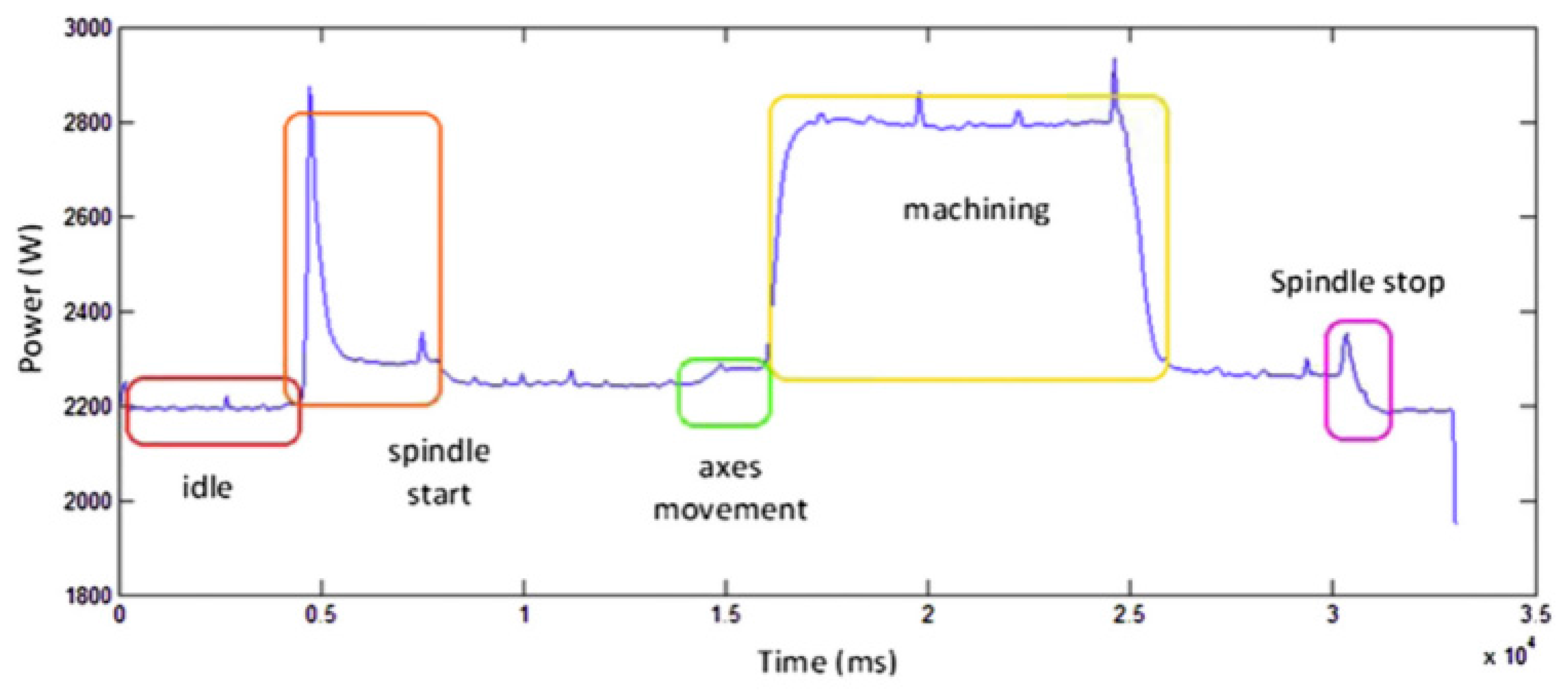
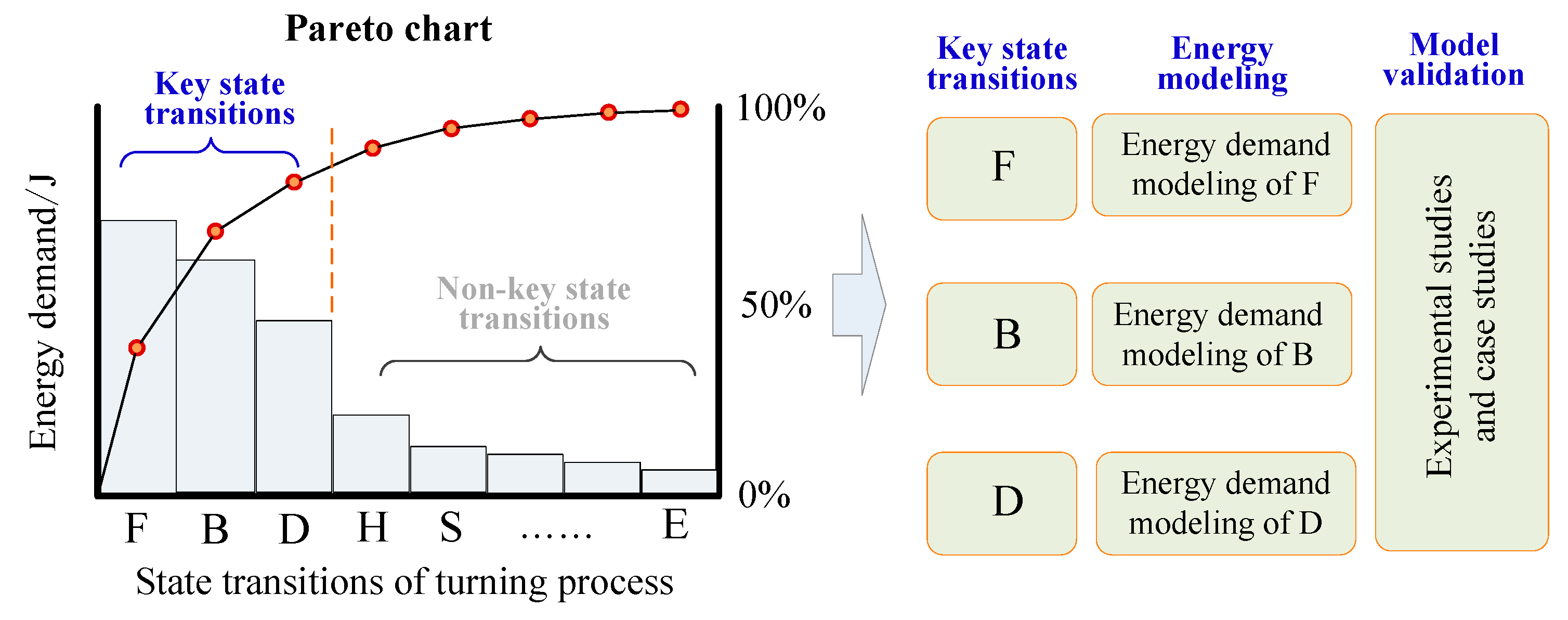

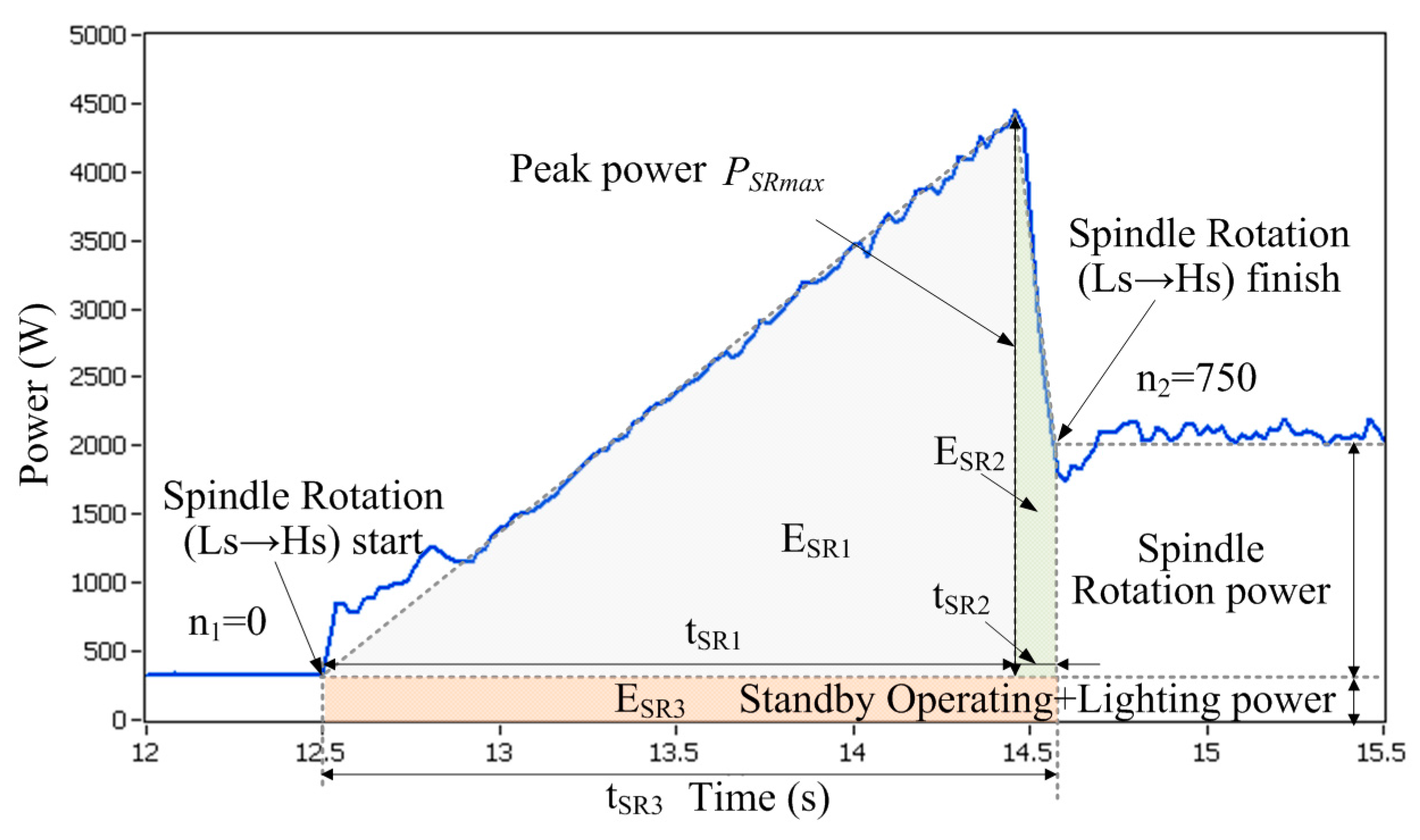

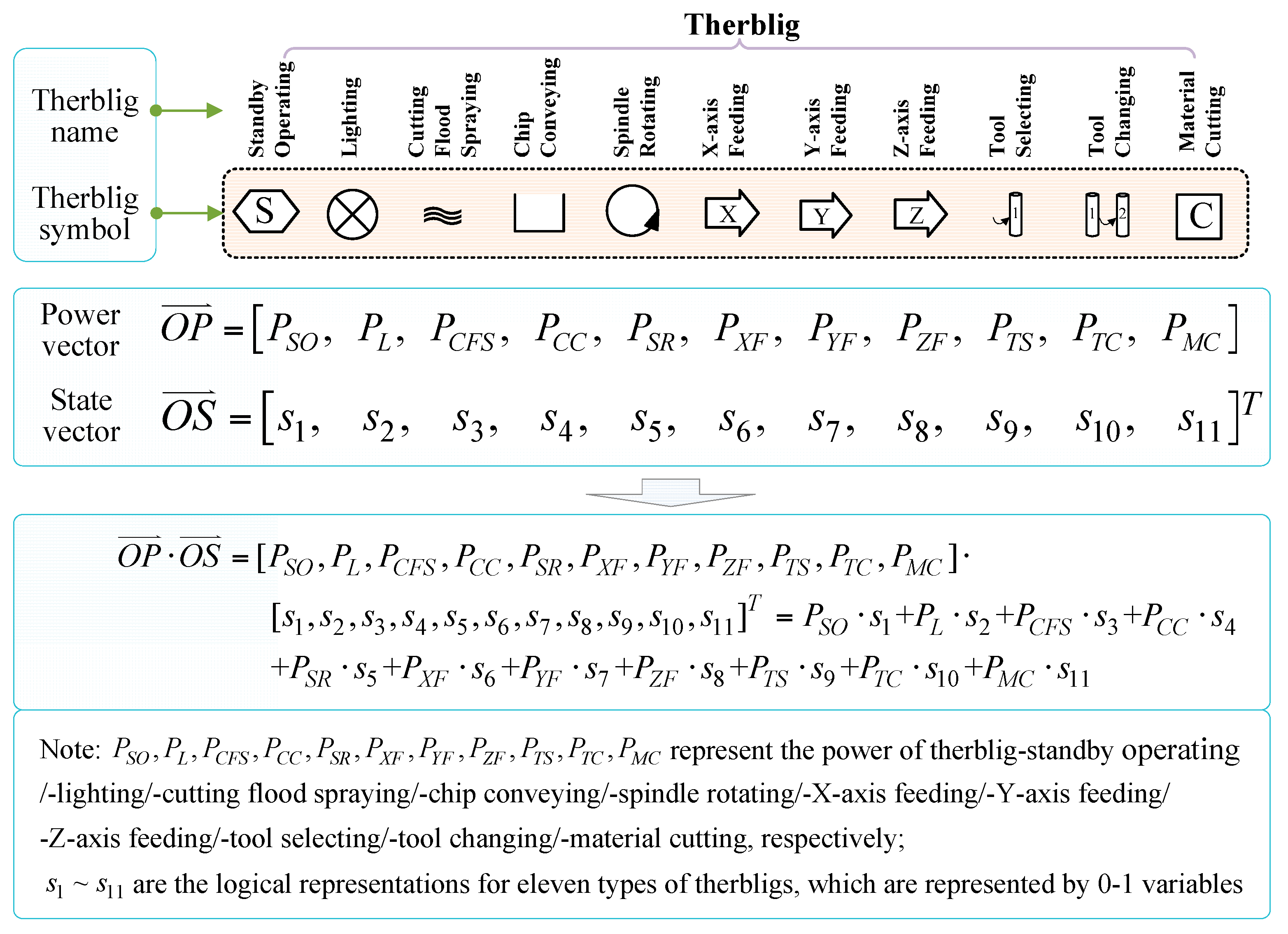
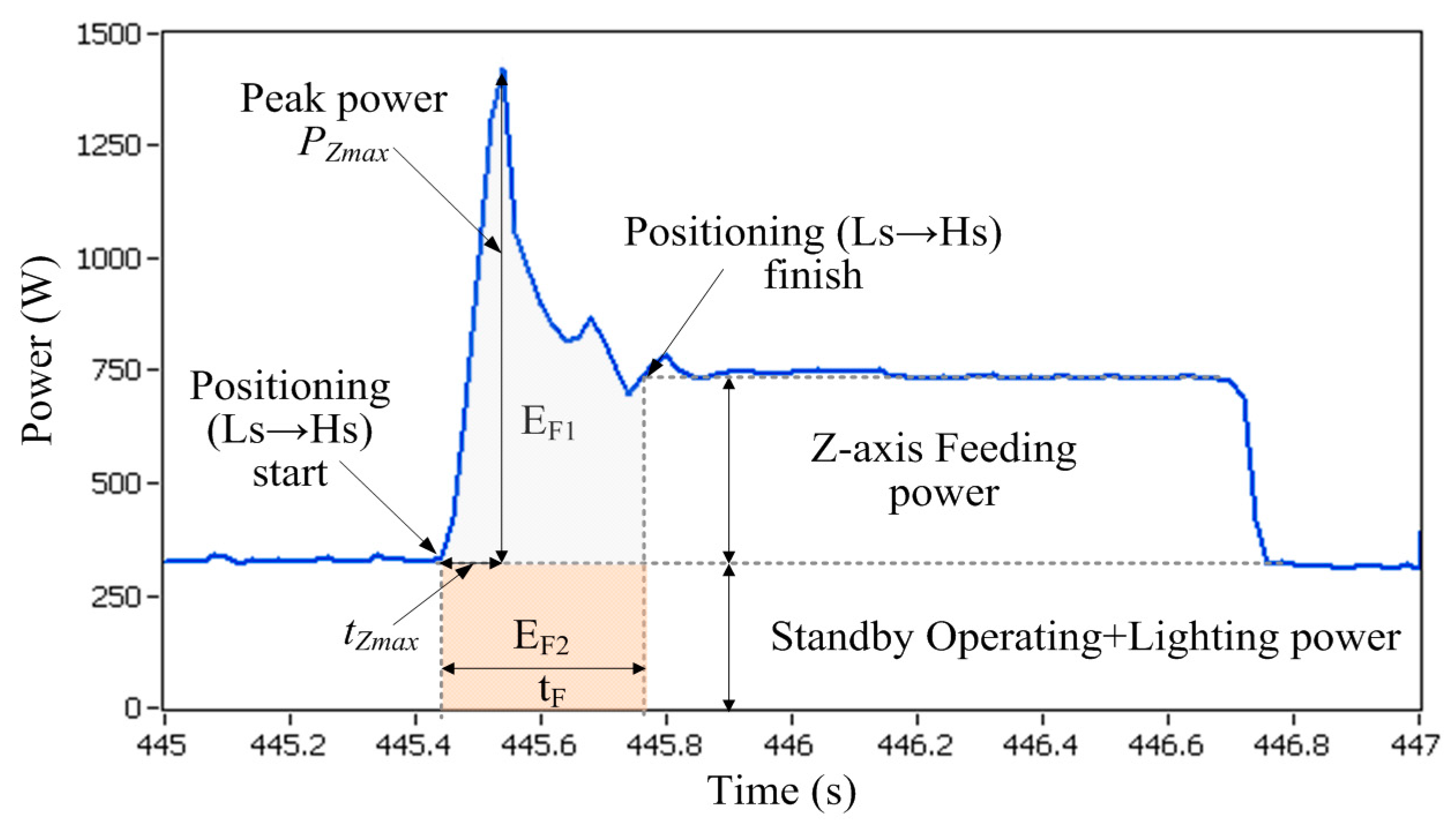


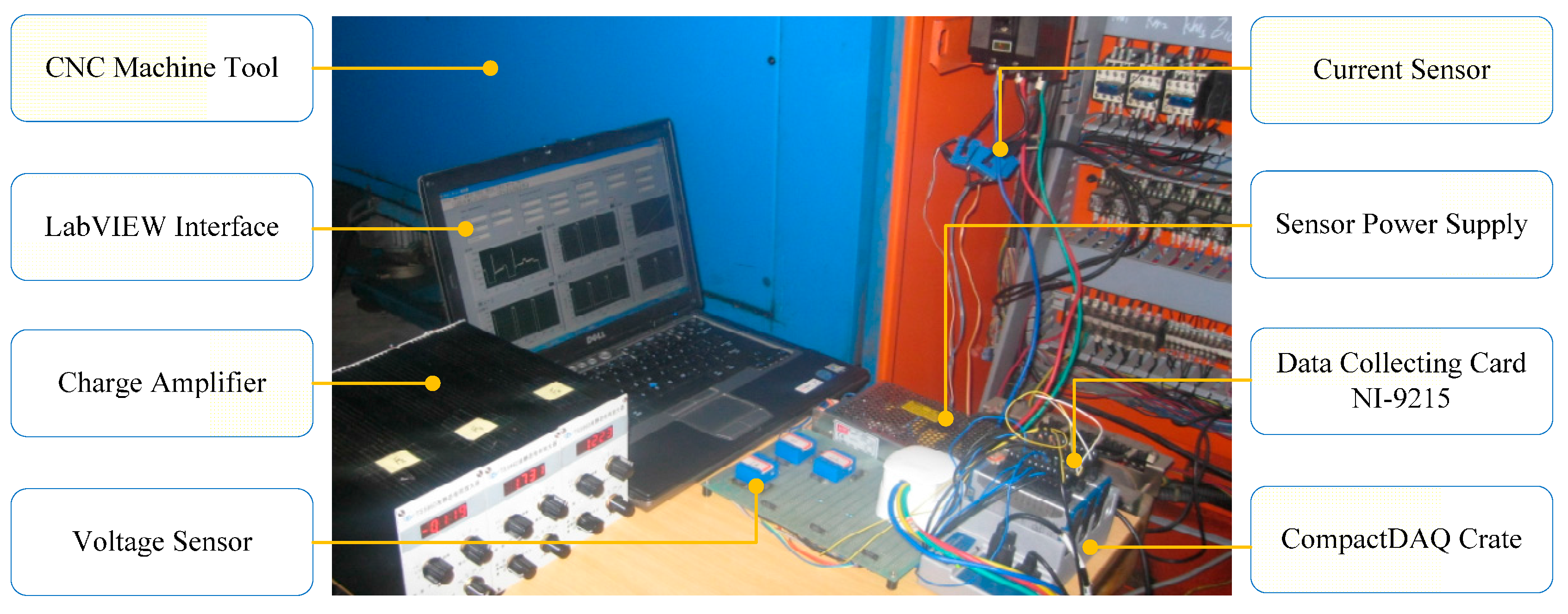
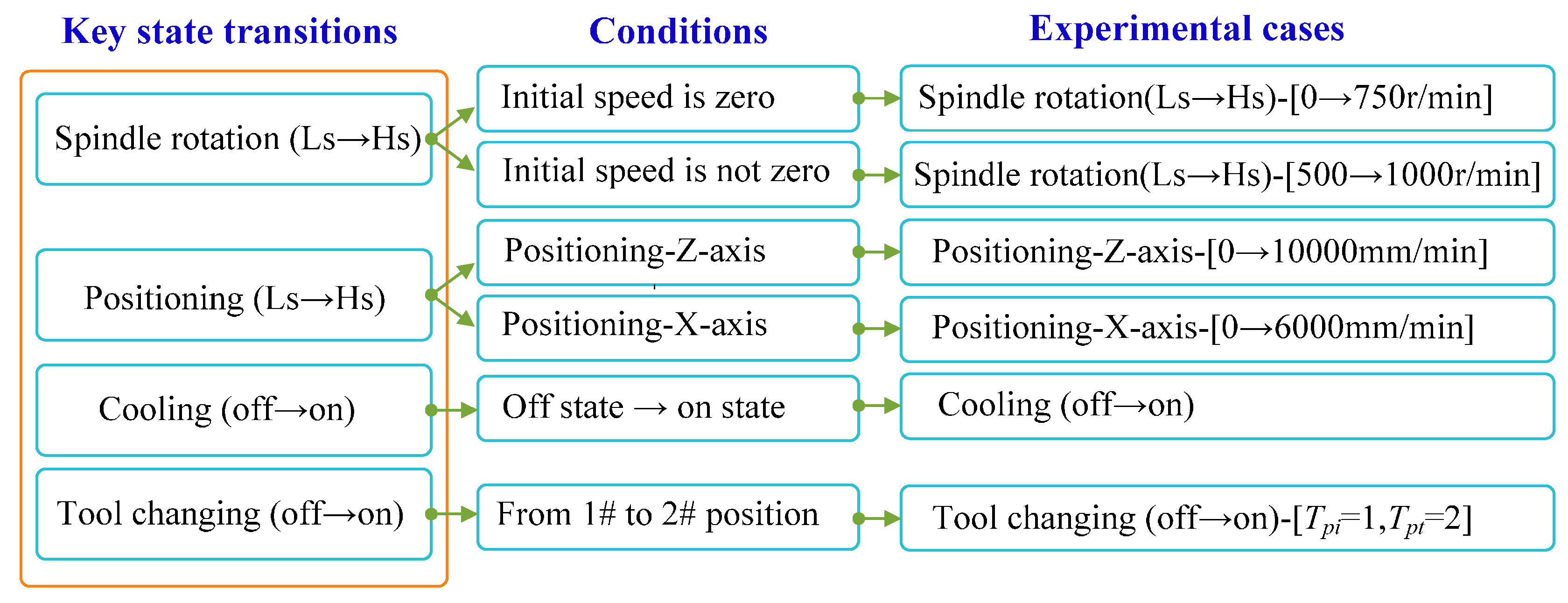
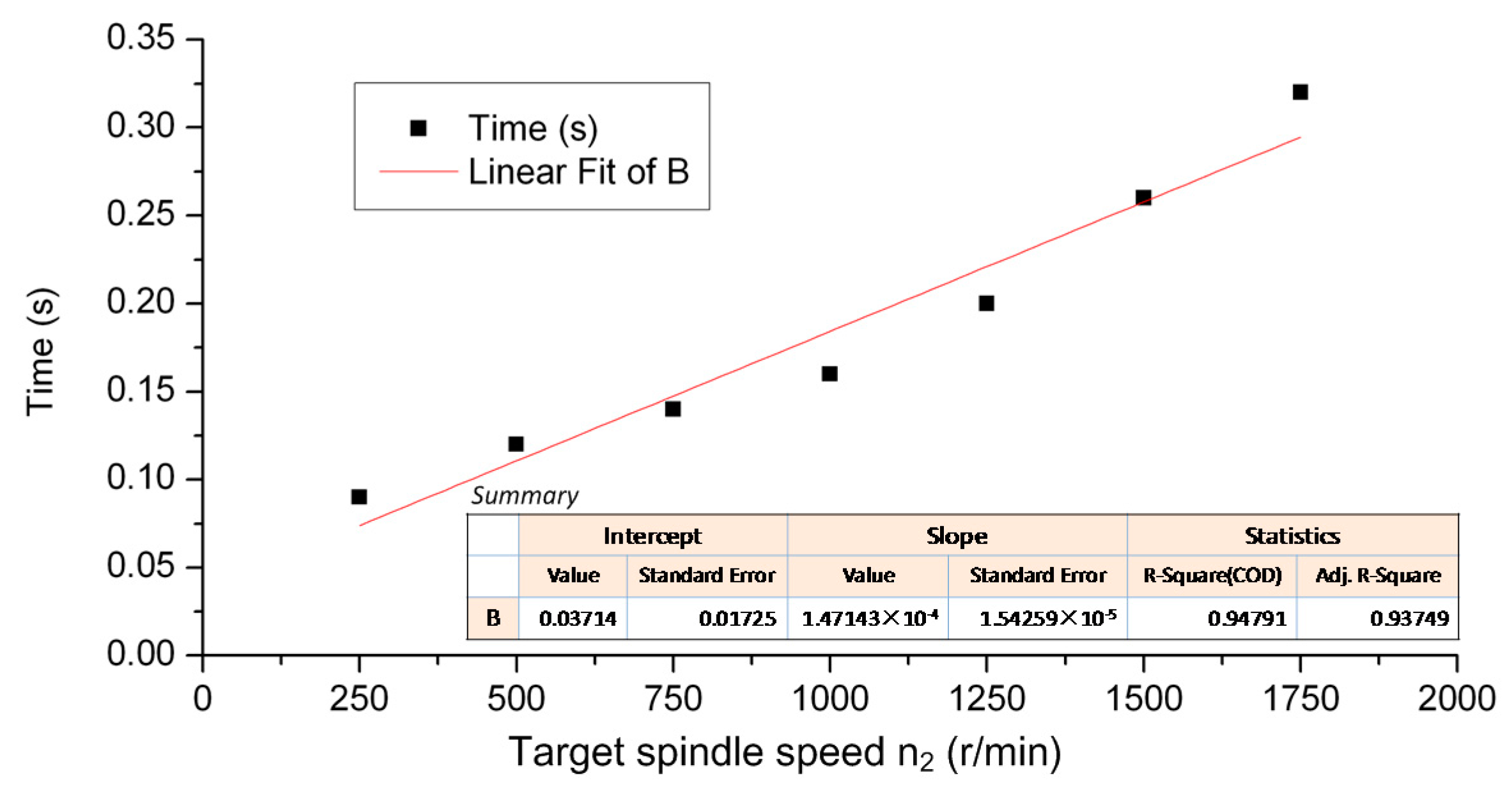
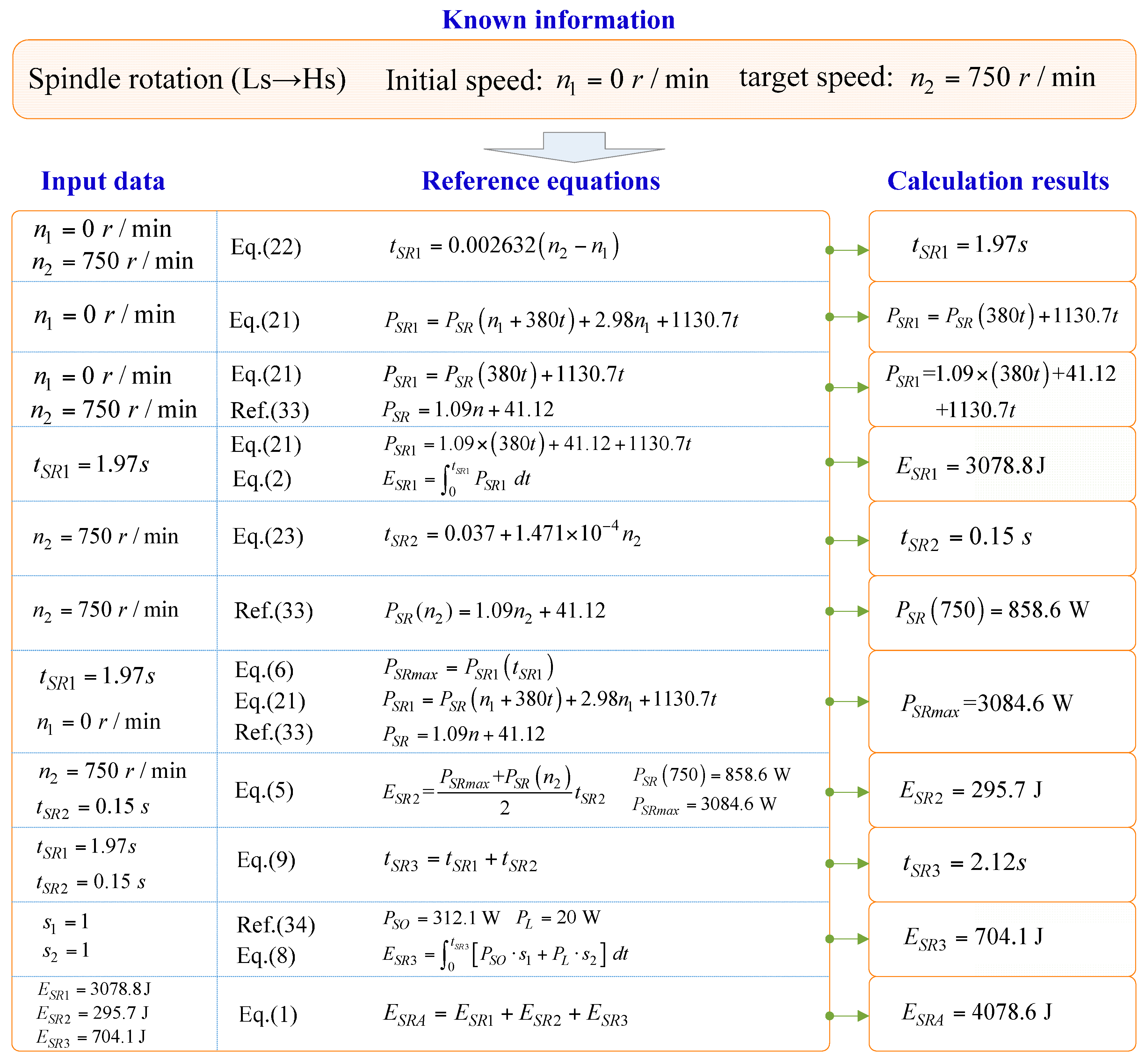
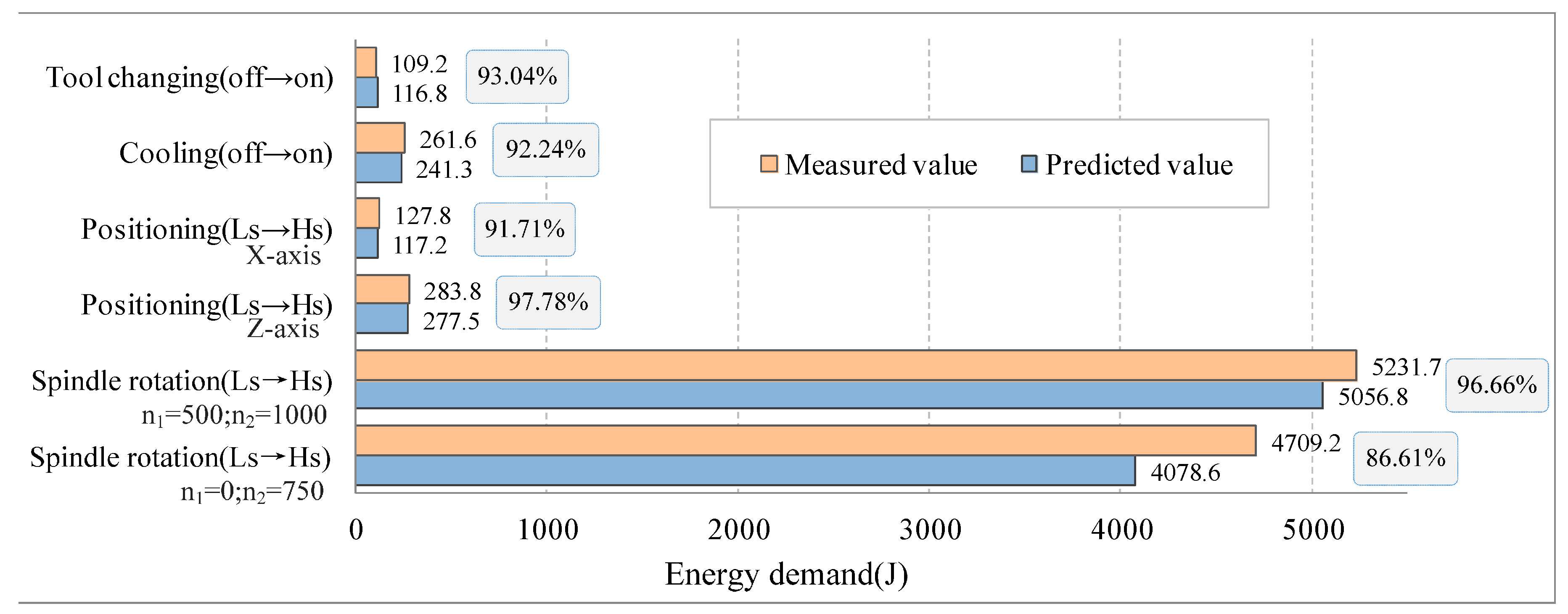


| State Transition | Main Parameters | ||
|---|---|---|---|
| Initial Parameter | Target Parameter | Supporting Therbligs | |
| Spindle rotation (Ls→Hs) 0→750 r/min | n1 = 0 r/min | n2 = 750 r/min | standby operating/lighting |
| Spindle rotation (Ls→Hs) 500→1000 r/min | n1 = 500 r/min | n2 = 1000 r/min | standby operating/lighting |
| Positioning (Ls→Hs) Z-axis | vrmin = 0 mm/min | vrmax = 10,000 mm/min | standby operating/lighting |
| Positioning (Ls→Hs) X-axis | vrmin = 0 mm/min | vrmax = 6000 mm/min | standby operating/lighting |
| Cooling (off→on) | Off state | On state | standby operating/lighting |
| Tool changing (off→on) | Tpi = 1 | Tpt = 2 | standby operating/lighting |
| Target Spindle Speed n2 (r/min) | tSR2 (s) |
|---|---|
| 250 | 0.09 |
| 500 | 0.12 |
| 750 | 0.14 |
| 1000 | 0.16 |
| 1250 | 0.20 |
| 1500 | 0.26 |
| 1750 | 0.32 |
© 2017 by the authors. Licensee MDPI, Basel, Switzerland. This article is an open access article distributed under the terms and conditions of the Creative Commons Attribution (CC BY) license (http://creativecommons.org/licenses/by/4.0/).
Share and Cite
Jia, S.; Yuan, Q.; Ren, D.; Lv, J. Energy Demand Modeling Methodology of Key State Transitions of Turning Processes. Energies 2017, 10, 462. https://doi.org/10.3390/en10040462
Jia S, Yuan Q, Ren D, Lv J. Energy Demand Modeling Methodology of Key State Transitions of Turning Processes. Energies. 2017; 10(4):462. https://doi.org/10.3390/en10040462
Chicago/Turabian StyleJia, Shun, Qinghe Yuan, Dawei Ren, and Jingxiang Lv. 2017. "Energy Demand Modeling Methodology of Key State Transitions of Turning Processes" Energies 10, no. 4: 462. https://doi.org/10.3390/en10040462





